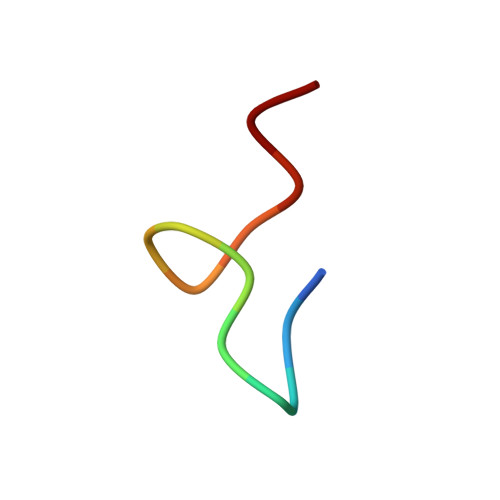Minor sequence modifications in temporin B cause drastic changes in antibacterial potency and selectivity by fundamentally altering membrane activity.
Manzo, G., Ferguson, P.M., Gustilo, V.B., Hind, C.K., Clifford, M., Bui, T.T., Drake, A.F., Atkinson, R.A., Sutton, J.M., Batoni, G., Lorenz, C.D., Phoenix, D.A., Mason, A.J.(2019) Sci Rep 9: 1385-1385
- PubMed: 30718667
- DOI: https://doi.org/10.1038/s41598-018-37630-3
- Primary Citation of Related Structures:
6GIJ, 6GIK, 6GIL - PubMed Abstract:
Antimicrobial peptides (AMPs) are a potential source of new molecules to counter the increase in antimicrobial resistant infections but a better understanding of their properties is required to understand their native function and for effective translation as therapeutics. Details of the mechanism of their interaction with the bacterial plasma membrane are desired since damage or penetration of this structure is considered essential for AMPs activity. Relatively modest modifications to AMPs primary sequence can induce substantial changes in potency and/or spectrum of activity but, hitherto, have not been predicted to substantially alter the mechanism of interaction with the bacterial plasma membrane. Here we use a combination of molecular dynamics simulations, circular dichroism, solid-state NMR and patch clamp to investigate the extent to which temporin B and its analogues can be distinguished both in vitro and in silico on the basis of their interactions with model membranes. Enhancing the hydrophobicity of the N-terminus and cationicity of the C-terminus in temporin B improves its membrane activity and potency against both Gram-negative and Gram-positive bacteria. In contrast, enhancing the cationicity of the N-terminus abrogates its ability to trigger channel conductance and renders it ineffective against Gram-positive bacteria while nevertheless enhancing its potency against Escherichia coli. Our findings suggest even closely related AMPs may target the same bacterium with fundamentally differing mechanisms of action.
Organizational Affiliation:
Institute of Pharmaceutical Science, School of Cancer & Pharmaceutical Science, King's College London, Franklin-Wilkins Building, 150 Stamford Street, London, SE1 9NH, United Kingdom.














